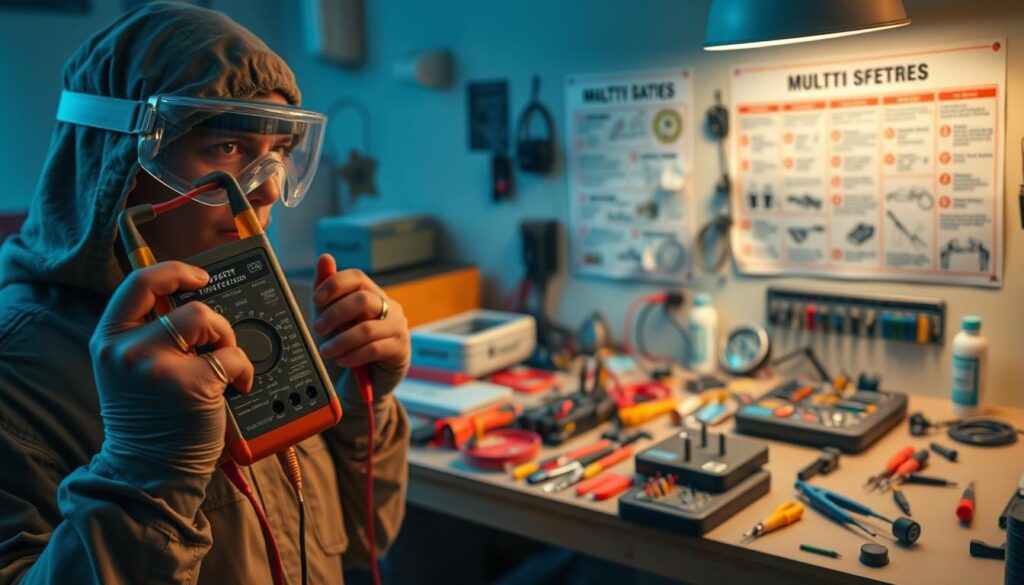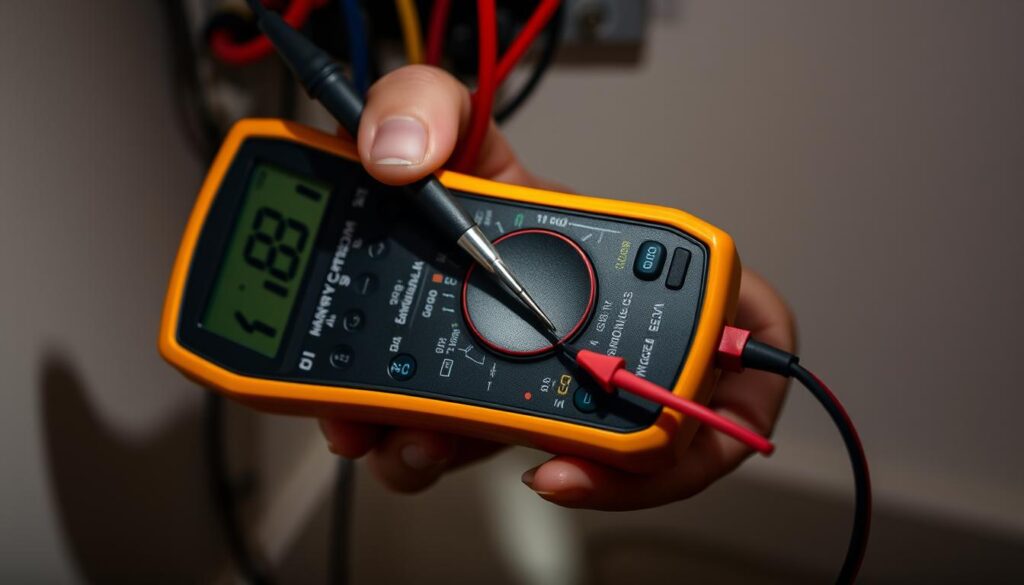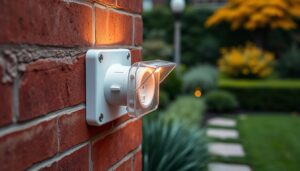Are you aware of the potential dangers lurking within your home’s electrical system? An undetected earth fault can lead to serious safety hazards, including electrical shocks and fires.
Understanding how to identify and resolve these issues is crucial for maintaining a safe environment. Using a standard multimeter, you can effectively diagnose problems and ensure your electrical system is functioning properly.
This comprehensive guide will walk you through the process, covering essential concepts and advanced troubleshooting techniques to help you pinpoint and fix issues efficiently.
Key Takeaways
- Understand the importance of identifying earth faults for electrical safety.
- Learn how to use a multimeter to diagnose electrical issues.
- Discover techniques for troubleshooting common problems.
- Gain confidence in resolving electrical faults safely.
- Ensure your home’s electrical system is functioning properly.
Understanding Earth Faults and Their Importance
Earth faults represent a significant hazard in electrical installations, necessitating a comprehensive understanding of their causes and implications. An earth fault occurs when there is an unintended path of electricity to the earth, often due to issues with the wiring or electrical components.
What Is an Earth Fault?
An earth fault is essentially a condition where a live wire or component comes into contact with the earth or a conductive path to the earth, causing unintended current flow. This can happen due to damaged insulation, moisture ingress, or other factors compromising the electrical system’s integrity.
Why Earth Faults Are Dangerous
Earth faults are dangerous because they can lead to electrical shock, fires, or equipment damage. When a fault occurs, it can create a conductive path to earth, potentially causing harm to individuals who come into contact with the faulty system. Moreover, earth faults can lead to significant downtime and costly repairs if not identified and rectified promptly.
Common Causes of Earth Faults
Several factors contribute to earth faults, including:
- Damaged cable insulation due to physical impact, age, or heat exposure.
- Moisture entering electrical enclosures.
- Poor installation practices.
- Rodent damage to cables.
To illustrate the causes and their effects, consider the following table:
| Cause | Effect |
|---|---|
| Damaged insulation | Unintended current flow to earth |
| Moisture ingress | Conductive paths between live components and earth |
| Poor installation | Insufficient clearance, leading to earth faults |
In battery systems, electrolyte leakage can also cause earth faults by creating conductive paths. Identifying and replacing faulty cells is crucial in such cases.
Essential Tools for Tracing Earth Faults
When tracing earth faults, having the right tools is crucial for a safe and efficient process. You need to be well-equipped to identify and rectify faults effectively.
Choosing the Right Multimeter
Selecting the best multimeter for electrical testing is vital. You should look for a multimeter that can handle the voltage levels you’re working with and has features such as continuity testing and voltage measurement. Consider a multimeter with a high level of insulation to ensure your safety while working with electrical systems.
Additional Equipment You’ll Need
In addition to a multimeter, you’ll need other equipment to effectively trace earth faults. This includes insulated tools, a voltage tester, and warning signs to keep others at a safe distance. Make sure you have all the necessary equipment before starting the testing process.
- Insulated gloves rated for the voltage level you’re working with
- Safety glasses or a face shield to protect against arc flashes
- Non-conductive footwear with electrical hazard protection
- Flame-resistant clothing for working with systems where arc flash hazards exist
Safety Gear Requirements
Safety should always be your top priority when working with electrical systems. Wear appropriate safety gear, including rubber gloves and safety glasses, to protect yourself from potential electrical shocks. It’s also crucial to have a clear understanding of the electrical system you’re working with and to follow proper safety protocols.
Before beginning any electrical fault tracing work, ensure you have:
- A properly rated voltage tester to verify power is off
- Warning signs and barriers to keep others at a safe distance
- An emergency plan and knowledge of first aid for electrical injuries
By having the right tools and following safety guidelines, you can confidently and safely test a ground wire with a multimeter.
Safety Precautions Before You Begin
Ensuring your safety is paramount when attempting to identify earth faults in your electrical system. Electrical safety is a critical concern, and taking the right precautions can prevent accidents and ensure a safe working environment.
Turning Off Power Sources
Before you start testing, switch off the main power supply to the circuit or system you’re about to inspect. This is a fundamental safety measure to prevent electrical shocks. Verify that the power is off using a voltage tester to ensure your safety.
Proper Handling of Testing Equipment
Handle your multimeter with care, and ensure it’s set to the correct function and range for your measurement. Inspect your leads for any damage before use, as frayed or damaged leads can lead to dangerous electrical shocks.

When to Call a Professional Electrician
If you’re unsure or uncomfortable testing the ground wire yourself, it’s always best to seek the help of a professional electrician. Some situations require expert intervention, such as intermittent earth faults, complex issues affecting multiple circuits, or faults in critical systems like fire alarms or medical equipment. In such cases, a professional electrician has the necessary expertise and equipment to diagnose and resolve the issue safely.
Some scenarios that necessitate calling a professional include:
- Detecting intermittent earth faults that you cannot consistently reproduce or locate.
- Testing revealing multiple earth faults or complex issues affecting several circuits.
- Earth faults occurring in critical systems or in areas with high moisture.
Your safety is crucial, and knowing when to call a professional can save you from potential hazards associated with electrical systems.
How to Trace Earth Fault with Multimeter
Tracing an earth fault with a multimeter is a straightforward process that requires some basic knowledge and precautions. To begin, you need to understand how to set up your multimeter correctly and perform the necessary tests.
Setting Up Your Multimeter Correctly
To trace an earth fault, you first need to set up your multimeter correctly. Ensure it’s set to the correct voltage range (usually AC) and that the leads are properly connected to the multimeter and the outlet you’re testing. The black lead should be connected to the neutral or common port, and the red lead should be connected to the live or voltage port.
Testing Between Live and Neutral
With your multimeter set up, insert the probes into the live and neutral slots of the outlet. Take a reading of the voltage between these two points. This will give you a baseline measurement to compare with your next reading. Record this reading so you can compare it with the reading between live and earth.
Testing Between Live and Earth
Next, remove the red probe from the neutral slot and insert it into the earth terminal (usually the top hole or metal parts of the outlet). Take another reading of the voltage between the live and earth points. In a correctly earthed system, this reading should be very close to the live-neutral reading (within 5V). If the reading is significantly lower, it indicates a poor earth connection. A reading of 0V suggests no earth connection is present, which is a serious safety issue. Record this reading alongside your live-neutral reading for comparison.
- With power still on, remove the red probe from the neutral slot and insert it into the earth terminal.
- In a correctly earthed system, the reading between live and earth should be very close to the live-neutral reading.
- A reading of 0V between live and earth suggests no earth connection is present.
- Record your readings for comparison to help identify the nature of any earth fault.
By following these steps and comparing your readings, you can effectively trace earth faults using a multimeter and ensure your electrical system is safe and functioning correctly.
Advanced Methods for Locating Earth Faults
When dealing with complex electrical systems, identifying earth faults requires more than basic troubleshooting techniques. Advanced methods are essential for accurately pinpointing the source of earth faults, ensuring efficient repairs and minimizing downtime.

Using the Continuity Test Method
The continuity test method involves using a multimeter to check for continuity between different points in a circuit. This method is particularly useful for identifying earth faults in complex wiring systems. By setting your multimeter to the continuity test mode, you can try to find the fault by checking for unexpected connections to earth.
To apply this method, start by isolating the circuit or component you suspect is faulty. Then, use your multimeter to test for continuity between the circuit’s live conductors and earth. A beep or a low resistance reading indicates a path to earth, suggesting an earth fault.
The Voltage Drop Method
The voltage drop method is another effective technique for locating earth faults. This involves measuring the voltage drop across different sections of a circuit under load conditions. A significant voltage drop can indicate the presence of an earth fault.
To use this method, you’ll need to measure the voltage between the circuit’s live conductors and earth at various points. Compare these readings to identify where the voltage drop is most significant, indicating the likely location of the earth fault.
Isolating Circuit Sections
Isolating circuit sections is a systematic approach to narrowing down the location of an earth fault in complex electrical systems. Begin by dividing the system into major sections that can be isolated using circuit breakers or disconnectors.
| Section | Isolation Method | Test Result |
|---|---|---|
| Main Distribution Panel | Circuit Breaker | No Fault |
| Sub-Circuit 1 | Disconnector | Earth Fault Detected |
| Sub-Circuit 2 | Remove Connections | No Fault |
After isolating each section, test for the presence of the earth fault using your multimeter. Once you’ve identified the faulty section, further subdivide it and repeat the isolation and testing process to narrow down the fault location.
Troubleshooting Common Earth Fault Issues
Troubleshooting earth faults requires a systematic approach to identify and rectify issues effectively. Earth faults can manifest in various forms and locations within electrical systems, making a comprehensive understanding of diagnostic techniques essential.
Identifying Faults in Battery Banks
Faults in battery banks can be particularly challenging due to their often enclosed and complex nature. To identify earth faults in battery banks, you should first isolate the bank from the rest of the system. Then, use a multimeter to check for any leakage between the battery terminals and the earth. A recording multimeter can be invaluable in monitoring the system over time to capture fault events.
Tracing Faults in Control Circuits
Control circuits, being integral to the operation of machinery and electrical systems, require precise fault diagnosis. Start by checking the wiring and connections for any signs of damage or wear. Use the continuity test function on your multimeter to verify the integrity of the grounding wire. If a fault is detected, isolate the circuit section by section to pinpoint the location.
Dealing with Intermittent Earth Faults
Intermittent earth faults can be particularly challenging to diagnose as they may come and go depending on various factors like temperature, humidity, or mechanical stress. To troubleshoot, monitor the system over time using a recording multimeter or earth fault relay. Check if the fault appears during specific conditions, such as certain weather conditions or when particular equipment operates. You can also try flexing cables or tapping equipment gently while monitoring for fault indications. In some cases, increasing the sensitivity of earth leakage detection temporarily can help identify the location of intermittent faults. Once located, treat intermittent faults as permanent faults and repair them thoroughly.
Conclusion
Using a multimeter to trace earth faults is an effective method for maintaining electrical safety in your home or workplace. By following the systematic approach outlined in this article, you can identify and resolve earth faults before they cause serious safety hazards.
Remember, safety must always be your primary concern when working with electrical systems. Regular testing of earth connections in your home or workplace can prevent dangerous situations and extend the life of your electrical equipment. The multimeter is your most valuable tool for earth fault detection, but knowing how to interpret readings correctly is equally important.
As you gain experience in tracing earth faults, you’ll develop an intuitive understanding of electrical systems that makes troubleshooting more efficient. Maintaining proper earthing throughout your electrical installation is not just about compliance with regulations – it’s about protecting lives and property from the dangers of electricity.
For complex or persistent earth faults, don’t hesitate to call a qualified electrician who has the specialized equipment and expertise to resolve difficult issues. By mastering the techniques described in this guide, you’re taking an important step toward ensuring electrical safety for yourself and others.
Continue to expand your knowledge of electrical systems and safety practices to become even more proficient at identifying and resolving earth faults. With practice and patience, you’ll become more confident in your ability to maintain a safe and reliable electrical system in your home or workplace.



